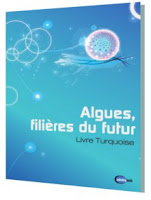 France (UE) 19/08/2011- 3B Conseils. BB. 2/2
France (UE) 19/08/2011- 3B Conseils. BB. 2/2Third generation biofuels bring together 70 companies all over the world. France is well placed. The Livre Turquoise sets out the general position on the exploitation of algae and their future role..... Among the developments, biofuel produced entirely from algae is seen as a 3rd generation energy source...
This is the extent of the daily news alert.. With effect from Sepetmebr 1st, you will need to be a suscriber to read the whole of the Daily News article.

In June 2010, at the Berlin Air Show, (ILA), EADS had the Diamond DA42NG (new generation)) flying daily on algal biofuel. 100 kilos of algae had been necessary to extract 22 litres of algal oil and from that 21 itres of biofuel. During its development phase this quantity of algae would have absorbed 182kgs of co2 and the biofuel obtained would have 8 times less fossil hydrocarbons than kerosene derived from petrol. The flights even showed a 5 to 10% fuel economy, and that without any modification of the engines. EADS had estimated that by 2030 biofuels could represent 30% of aviation fuel consumption.
The Livre Turquoise (French only) offers a synthesis of scientific, technical, and economic knowledge in the domain, an analysis of the two streams - micro and macro-algae (participants, projects, advantges, blockages, perspectives) and a road map with the different specific strategic proposals validated by all the participants. Its objective is to "Contribute to the organisation and development of the French algal industry sectors".
Adebiotech and their partners, the sponsors of excellence Pôle Mer Bretagne, and Pôle Mer PACA (both sponsors of our publications), together with Industries & Agro-Ressources (IAR), and Trimatec; the clusters Atlanpole Blue Cluster and Algasud, le CEA, Veolia Environnement and Fermentalg made it possible to publish the Livre Turquoise, (French only), at once a report and the minutes of the symposium «Algae, sectors of the future ». It can be downloaded from here. The report is addressed to all the participants be they government institutions, academics, or insutrialists, wanting information about current and potential applications for micro and macro-algae: food, health, cosmetics, the environment, green chemistry,, and of course biofuels.
A little history of algae with Biofutur, that is publishing a special edition on the occacion of the BioMarine convention that is being held from 7th ton9th September in Nantes (France), jointly organised by Bio-Marine Pierre Erwes with Atlanpole Blue Cluster, initiative conjointe entre la CARENE et Atlanpole avec le soutien des régions Pays de la Loire et Poitou‐Charentes.
Pierre Tramoy of CBDMT, member of the Board of Algénics, recalls that the main use of micro-algae for thousands of years was for food, their commercial use only started in the 1960s in Japan with chlorelles, by Nhion Chlorella, followed by spirulines in 1969 in Mexico, by Sosa Texcoco. The energy crisis of the 1970s showed the enormous potential of micro.algai biomass as renewable fertilizer and fuel stock. Ten years later almost 40 Asian fatories were producing a dozen tons of micro-algae, mainly chlorellas. The 1980s saw the start of large-scale produciton of new micro-algae, Dunaliella salina and the cyanobacteria. A rich source of b-carotène, D. salina is to-day the third most widely traded micro-alga.
With the general explosion of renewables energies in the year 2000, the production of biofuel from micro-algues has come to the forefront. Their high lipids content and their high productivity have attracted hundreds of miilions of €uros sinc2 2007 in companies developing 3rd generation biofuels.
Although according to a study that he undertook, the range of possible applications of these photosynthesizing organisms is very wide, but few analysts have focussed on their commercial potential. Only a dozen of micro-algae are to-day on the market: spirulines, chlorellas and algae of the species Crypthecodinium, Dunaliella, Haematococcus, and Ulkenia. The industry exploits them in the form of dried biomass (whole micro-algae or extracts), in segments of the market as diverse as human and animal nutrition, cosmetics, or research. Several tens of tons of dried biomass are produced annually in the world. (1). With a market of almost €600m, spiruline and the specias Crypthecodinium jointly represent three-quarters of commercial production. The principal end-uses are carotenoïds, phycobiliproteins (pigments) and anti-oxydants. More than 50% of biomass production are used by them. Total sales of finished products are now worth some €4bn. worldwide.
Valeurs Vertes has also just published an interview with Jérémy Pruvost, a member of the GEPEA laboaratory based in Nantes (Génie des Procédés, Environnement, Agroalimentaire, Energie, Mer), the only French laboratory to work on the industrial processes that incorporate micro-algae. "Everything that we do with terrestrial plants, we will do better with micro-algae, a whole new world ...." according to Jean-Paul Cadoret, founder and director of the scientific council of Algenics. Directeur du laboratoire Physiologie et biotechnologie des algues, Ifremer Nantes était intervenu aux entretiens sur les énergies de la mer dans le cadre de Science et Ethique à Brest (TV Web lors d'une des toutes premières présentation du Projet Shamash)...
Sources : BioFutur, Valeurs Vertes, l'actualité Chimique, BioMarine, 3B Conseils
Original Article : Brigitte Bornemann; translated and edited by Christopher LONGMORE.
No comments:
Post a Comment